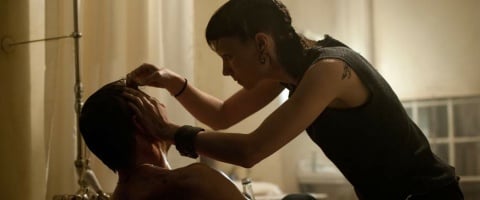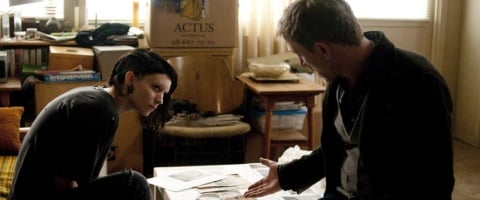Dragon Tattoo's Mara, Craig And Fincher Talk Motorcycles And Suffering Take After Take
Craig, Mara and director David Fincher were on hand in New York this weekend to talk about the film.

A day ahead of the Christmas rush, The Girl With The Dragon Tattoo opens in theaters today, meaning you can get a jump start on what they're calling "The Feel-Bad Movie of Christmas." Starring relative newcomer Rooney Mara as the enigmatic hacker Lisbeth Salander, with James Bond himself Daniel Craig as the journalist Mikael Blomkvist, Dragon Tattoo is unrepentantly violent and grim, but also surprisingly enjoyable-- maybe not so surprising if you're one of the 60 million people who's read Stieg Larsson's book.
Craig, Mara and director David Fincher were on hand in New York this weekend to talk about the film, their efforts not to think too much about the original Swedish adaptations of the book, the various ways both actors suffered to play their characters, and why Daniel Craig wasn't allowed to ride on the back of Lisbeth Salander's motorcycle. As usual at a press conference, the questions were kind of all over the place, so I've tried to organize them by theme and condense as much as possible. Check out what they had to say about the film below, and find The Girl with the Dragon Tattoo in theaters everywhere today.
By now Rooney Mara's arduous audition process to play Lisbeth is fairly infamous-- she went back to read for Fincher multiple times, had to act the rape revenge scene and immerse herself in the character before she even knew the part. At the press conference Fincher talked about how he cast Mara with Daniel Craig already on board, and Mara talked about the list of things she knew in advance she'd have to do if she got the part.
Fincher: The casting process began with Daniel. Obviously, you build your universe. It is like building a basketball team. I knew him to be self effacing and to be playful and witty. I knew that I needed that for Mikael as well that I wanted a very masculine kind of center to the film. The androgynous side of the movie would be carried by Rooney. That was her job. [Lisbeth and Mikael] are sort of unable to be close to one another. They sort of push against each other. So I started looking at the things about Lisbeth that I wanted to see and I didn’t see them initially in anyone that we were looking at and Rooney was right under our noses. I had already spent 4 or 5 days with her on The Social Network. [In casting] I look for an inherent kind of quality. You are going to be shooting 14 hour days and you are going to be tired. You are going to not necessarily be able to conjure armor or a façade every single moment. You want the actor to have…I liken it to a quality that you kind of can’t beat out of them with a tire iron.
Rooney was somebody that we brought back time and time again not because we didn’t see what we were looking for, but because initially when…the problems she was solving for me at the beginning of The Social Network were that she was intensely feminine, very mature, warm, verbal, and she was trying to build a bridge desperately to Jesse [Eisenberg] in those 5 ½ minutes that she is on screen., and none of those qualities applied to Lisbeth. In fact, they were the antithesis. So every time she would come in and we would work together I would say, “Okay. Now here is a new hurdle and you have to jump this.” So finally after two and a half months the quality that was undeniable, and the thing that seemed to be the most Lisbethian, was that she was just not giving up. She was indomitable. There were times where I was personally embarrassed to say, “I need you to come back one more time.” There was never a moment where she was like “Ugh!” I know that I would have. At the end of it, when we put her on the plane to go to Stockholm by herself for 5 weeks to learn how to ride a motorcycle and find an apartment, we knew we had the right people.
Mara: David had told the casting director to let me know before I went down the long road of auditioning that if I were to get the part that I would have to become a smoker and have to go off and be among myself for a year. I would have to be butt naked, do these horrible rape scenes, ride a motorcycle, and what else was on the list?
Fincher: Skateboard?
Your Daily Blend of Entertainment News
Mara: No. That wasn’t on the list. That came later.

Lisbeth Salander is the iconic center of the Dragon Tattoo books, but though she get revenge against her rapist and saves Mikael over and over again, Mara and Fincher both bristled at a question that likened her to a comic book hero-- says Mara, "That was never our intention. We always wanted to make her very human." Instead she talked about how the motorcycle stunts were what she dreaded most in the shooting, and also how the character lingered with her even when walking on the street after a day of shooting.
Mara:The motorcycle was definitely the thing that I was the least excited about doing. It just seemed very dangerous to me.
Fincher: It is dangerous.
Journalist: Were you going that fast?
Craig: Yes.
Mara: Someone was.
Fincher: We so desperately wanted to do a scene with him on the back of the motorcycle.
Mara: Daniel wouldn’t get on the back.
Craig: That is not true!
Fincher: We couldn’t get insurance for that if Rooney was going to drive.
Mara [later, on the Lisbeth costume]: The hair was stuck to my head so there wasn’t much I could about that. The eyebrows remained bleached and the piercings that I got that were real obviously stayed in. Obviously, I wasn’t wearing my wardrobe at home at night. I expected people to treat me much differently, but it really didn’t happen. The biggest change that I noticed was that when you look slightly off in that way people sort of pay less attention to you and their expectations of you are lowered. I didn’t mind that and actually enjoyed that.
Mara was not the only one who had to suffer for her art. In a scene late in the film, Craig's character Blomkvist is strung up in a sort of torture device, and… well, let Fincher and Craig explain how much real pain that required the actor to go through.
Fincher: The first night that we got to hoisting him the stunt coordinator came in and said, “Daniel has to hold this little metal thing in his hand so that if he does lose consciousness…because he is going to be acting like he is suffocating, which is not very different from actually suffocating.” So it would be hard to see. So he would have this little metal thing in his hand and he was hoisted up and we were rolling.
Mara: How come you didn’t do that for me? [Referring to her rape scene early in the film, in which she's bound and gagged].
Craig: There was a code word.
Fincher: Yeah, the code word was “Hmmmph!” [laughter] So he had this thing in his hand and as I am watching the monitor I hear “Ting! Ting! Ting!” We rushed in and he had passed out. So we wrapped then. On the production report was “Let Daniel go 15 minutes early due to unconsciousness.” [laughter]
Craig: Just another day working with David Fincher. [laughs] The most important thing about this character for me was to make him as real and as believable as possible. Obviously, there is another person that I play [James Bond, of course] that would deal with it in a different way. It wasn’t like I was ever thinking about that. I wanted to put the reality into this. He gets shot and runs away screaming like anybody else would. That was really the key and it was dead easy. Just to be sort of by the by, but that is what I love about this character and the relationship he has with Salander. He doesn’t have to prove that he is a man. He is a guy and he doesn’t have to go around beating his chest and he is very happy to fall into this relationship where she is literally wearing the trousers.
Fincher: Leather trousers.

Though the movie is very measured and often very restrained, it opens with practically a primal scream, with Karen O's cover of "Immigrant Song" by Led Zeppelin, set to animated opening credits that look a little like Salander rising from molten steel. Fincher explained how he convinced Led Zeppelin to provide the rights to "Immigrant Song," and also what appealed to him about such a bold opening sequence.
Fincher: Led Zeppelin is very protective, as they should be. They have an amazing catalog I think they wanted to make sure that we respected it and it was our intention all along to communicate the idea that we didn’t want to run it into the ground. We didn’t want to use it in every television spot. We wanted to pick specific places like the teaser and the title sequence to do it. We needed to make sure that they understood that it was going to be a cover. We weren’t going to be licensing the actual performance. We wanted to do it with a woman’s voice. So it kind of went down like clockwork.
I think title sequences are an opportunity to sort of set the stage or to get people thinking in different terms than maybe whatever they understand the movie to be going in. Often times when movies are marketed they are marketed towards the idea of “What is the consensus that everybody has that will get them into the 7 o’clock show?” So often times a title sequence can help to sort of reorient their thinking. I liked the idea of this sort of primordial sort of tar and ooze of the subconscious. I liked the idea that it was sort of her nightmare.
Fincher has been very frank about the fact that the mystery of the story, in which Salander and Blomkvist solve a decades-old murder, is the last thing that interested him about Stieg Larsson's novel, even though he knows that's what a lot of people loved about it. Allow him to explain further.
Fincher: The mystery of this movie wasn’t that interesting to me. You know, Nazis, serial killers, and the evil that people do in their basements with power tools wasn’t the thing that…the thing that was first and foremost was this. I hadn’t seen this partnership before. I hadn’t seen these two people working before to do anything. So I liked the thriller and I liked the vessel of that, but I was really more interested in the people front and center.
Craig, Mara and Fincher were all happy to distance themselves from the source material and comparisons to either the Swedish films or the book. Though Fincher did pay respect to the book in an interesting way, keeping in a brief subplot in which Salander picks up another woman at a punk gay club.
Mara: To be honest, I didn’t really think much about what other people imagined it to be. I used what I imagined it to be. I had read all three books and I had a really clear picture of who this girl was. Luckily, David’s idea was pretty similar. I didn’t really think much about what other people thought of her.
Craig: Exactly. In this industry, the less you think about what other people are thinking about, the better and more original you can be. You can’t go into a project thinking. “How will these people like it? How will those people like it?” You want to be single minded about it. You can’t please everybody.
Fincher: We start with the source material. We start with the book and [Lisbeth's bisexuality] is what the book described. I didn’t feel there was any need to put a frame around it. One of the things we were very particular about was when she meets Miriam Wu in the bar. We wanted that to be a moment of happiness. There are two times that you see her smile in the entire movie and one of them is when is she gets the attention of Elodie [Yung] and Elodie comes over to kind of say, “Why are you here alone?” I thought that was important. I also think that Salander’s sexuality is less of a ambidextrous thing than it is something that she has to act on. I think the tragedy is that friction is not a problem for her; intimacy is a problem for her. I know that, to me, was the important thing to show.

David Fincher is famous for putting his actors through many, many takes of a given scene, and that was no exception even in the violent and disturbing moments of Dragon Tattoo. Fincher talked a bit about how he chooses his actors, and Mara and Craig downplayed the challenges of doing so many takes-- unsurprising, since the director was sitting right there.
Fincher: I like people. I like people that like to work the way that I like to work. If we have an unspoken understanding and a way of communicating that is easy or if we have been through it before and we know. Sometimes people freak out when you shoot 40 takes of something. They start looking at you like, “What did I do wrong?”, and its like “No. It’s not wrong. It’s just that we are going to try something different.” So that could be one of the reasons. Also, I like certain people’s energies and I feel like those are things that you want to….”This person could work really well in this situation.” Hopefully, you are not going to the well for the same thing every time. It’s certainly not in Rooney’s case.
Mara: You don’t really think about [the additional takes] after awhile. It is very exaggerated and dramatized. I think our average take count was much less than that.
Craig: You don’t count. You really don’t count.
Journalist: Did you feel that you get better and better?
Craig: No. Sometimes you get worse and worse and then it kind of changes.
Mara: Usually you get worse and worse in the middle.
Craig: But, as David said, someone throws a lot of money at you to get to do something like this. You are there to do it right. Things get frustrating in a work day and there are lots of other things to get frustrated about, but then there are a lot of triumphs at the end of the day. You can’t get down about it.
Staff Writer at CinemaBlend

